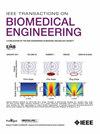ThermICA: Novel Approach for a Multivariate Analysis of Facial Thermal Responses
IF 4.4
2区 医学
Q2 ENGINEERING, BIOMEDICAL
引用次数: 0
Abstract
ThermICA:面部热反应多变量分析的新方法。
目的:在临床医学和心理生理学中,红外热成像技术(IRT)已被用于以非接触方式监测皮肤温度变化。在此,我们介绍一种新方法,从红外记录中获取与出汗、外周血管舒张和呼吸有关的自律神经相关信息:我们的方法包括使用独立分量分析(ICA)对面部热图进行基于模型的分解,以及一个临时预处理程序。我们在 30 名健康志愿者身上测试了我们的方法,作为实验方案的一部分,他们的心理生理状态受到了刺激:结果:受试者内 ICA 分析确定了三个独立成分,它们与参考生理信号具有相关性。此外,独立分量的线性组合可有效预测每种生理信号,皮电活动的中位相关性为 0.9,呼吸的中位相关性为 0.8,光电血压峰包络的中位相关性为 0.73。此外,我们还进行了受试者之间的交叉验证分析,从而可以从未曾见过的受试者面部热成像图中预测生理信号:我们的研究结果验证了从原始信号和热衍生信号中提取的特征在区分实验条件方面的功效。这一结果强调了我们方法的灵敏度和前景,主张在生物医学信号分析中扩大对热成像的研究。它强调了热成像在增强情绪状态客观评估方面的潜力。
本文章由计算机程序翻译,如有差异,请以英文原文为准。
求助全文
约1分钟内获得全文
求助全文
来源期刊

IEEE Transactions on Biomedical Engineering
工程技术-工程:生物医学
CiteScore
9.40
自引率
4.30%
发文量
880
审稿时长
2.5 months
期刊介绍:
IEEE Transactions on Biomedical Engineering contains basic and applied papers dealing with biomedical engineering. Papers range from engineering development in methods and techniques with biomedical applications to experimental and clinical investigations with engineering contributions.
 求助内容:
求助内容: 应助结果提醒方式:
应助结果提醒方式:


